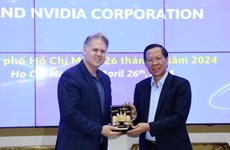Vietnam, ADB sign 1.38 bln USD assistance package
State Bank of Vietnam Governor Nguyen Van Giau and Asian Development
Bank (ADB) President Haruhiko Kuroda signed a 1.38 billion USD financial
assistance package in Hanoi on May 5.
State Bank of Vietnam Governor Nguyen Van Giau and Asian Development
Bank (ADB) President Haruhiko Kuroda signed a 1.38 billion USD financial
assistance package in Hanoi on May 5 to enhance Vietnam’s nationwide
clean water access, conserve threatened forests, and ease urban
gridlock.
The total cost of the three projects is almost 4.5 billion USD.
“ADB’s assistance will help ensure that more people in Vietnam have access to clean water, more livable cities, and biologically diverse forests that will be preserved for future generations,” said President Kuroda.
In many of Vietnam’s largest cities, 30 percent to 40 percent of treated water is lost before it reaches the end user. Moreover, four in every ten families have no connection to a central water supply system.
A 1 billion USD financial support mechanism from ADB will help improve clean water access for 3 million families in Vietnam’s cities, including half a million poor households who will receive their own piped water connection for the first time. The assistance is part of a 2.8 billion USD investment programme.
A 30 million USD loan from ADB’s concessional Asian Development Fund will enhance cross-border cooperation in protecting a contiguous stretch of biodiversity-rich forest in Viet Nam’s Central Annamites, which spans the highlands of Quảng Trị, Thừa Thiên-Huế and Quảng Nam provinces. This is part of a larger programme that is also supporting the preservation of key forestlands in Cambodia and Laos.
The assistance package for Vietnam includes approximately 8 million USD to improve clean water and sanitation services and upgrade market roads in the 34 largely ethnic minority communes in the project area.
The third component of the assistance is a 350 million USD loan, which is the first tranche of an overall 636 million USD ADB package. This package is supporting a 1.6 billion USD project to construct a modern expressway to the south of congested Ho Chi Minh City.
The 57-kilometer expressway between Ben Luc and Long Thanh will reduce traffic in the heart of HCM City by allowing vehicles traveling from east to west to bypass the city centre. When the full expressway opens in 2017, it is expected to reduce east-west travel time by 80 percent and cut the number of traffic accidents by 10 percent./.
The total cost of the three projects is almost 4.5 billion USD.
“ADB’s assistance will help ensure that more people in Vietnam have access to clean water, more livable cities, and biologically diverse forests that will be preserved for future generations,” said President Kuroda.
In many of Vietnam’s largest cities, 30 percent to 40 percent of treated water is lost before it reaches the end user. Moreover, four in every ten families have no connection to a central water supply system.
A 1 billion USD financial support mechanism from ADB will help improve clean water access for 3 million families in Vietnam’s cities, including half a million poor households who will receive their own piped water connection for the first time. The assistance is part of a 2.8 billion USD investment programme.
A 30 million USD loan from ADB’s concessional Asian Development Fund will enhance cross-border cooperation in protecting a contiguous stretch of biodiversity-rich forest in Viet Nam’s Central Annamites, which spans the highlands of Quảng Trị, Thừa Thiên-Huế and Quảng Nam provinces. This is part of a larger programme that is also supporting the preservation of key forestlands in Cambodia and Laos.
The assistance package for Vietnam includes approximately 8 million USD to improve clean water and sanitation services and upgrade market roads in the 34 largely ethnic minority communes in the project area.
The third component of the assistance is a 350 million USD loan, which is the first tranche of an overall 636 million USD ADB package. This package is supporting a 1.6 billion USD project to construct a modern expressway to the south of congested Ho Chi Minh City.
The 57-kilometer expressway between Ben Luc and Long Thanh will reduce traffic in the heart of HCM City by allowing vehicles traveling from east to west to bypass the city centre. When the full expressway opens in 2017, it is expected to reduce east-west travel time by 80 percent and cut the number of traffic accidents by 10 percent./.













